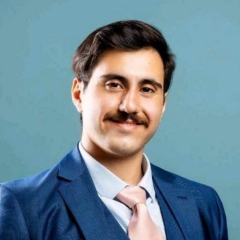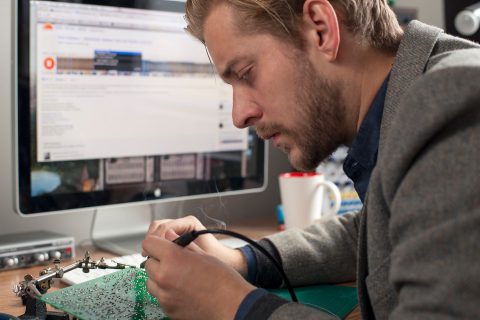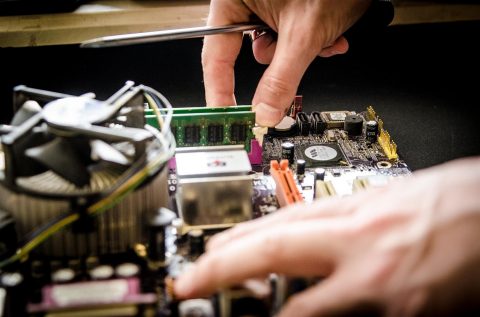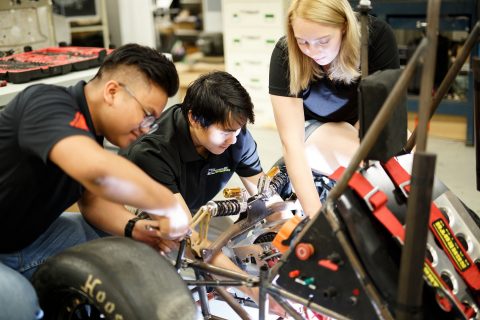Aerospace Engineering (BEng)
Virtual information sessions
Want to know how we're training the next generation of engineers and computer scientists? Join us to learn about the Gina Cody School's undergraduate programs and plans to advance integrated technologies in a socially responsible manner.
Why study Aerospace Engineering?
Design airplanes. Build helicopters. Test unmanned air vehicles.
Aerospace engineers master the mechanisms behind flight and propulsion in the atmosphere and in space. Choose to specialize in Aerodynamics and Propulsion, Aerospace Structures and Materials, or Avionics and Aerospace Systems. Through labs, lectures and projects, you’ll also:
- Apply mechanical, electrical, computer, and industrial engineering to the conception, design, implementation and operation of aerospace systems and processes
- Solve problems using the techniques of mathematics, physics, modeling, and simulation
- Gain practical insights into modern industrial practice
Our state-of-the-art labs give you experience with the tools and equipment you may use in the field. Montreal represents one of the three largest aerospace clusters in the world. After completing their degree, students will be in a position to use their advanced aerospace engineering knowledge and their creative, inquisitive and analytical skills in industry, government and service sectors.
Program highlights
- Super-engaged student groups including Space Concordia, a student-run space agency focused on developing and achieving operational excellence across rocketry, satellite, and space robotic domains.
Special funding for out-of-province students
Up to $4000 for undergraduate programs.
Program structure
A Bachelor of Engineering degree takes a minimum of four years (120 credits) of full-time study, depending on your academic background.
Program options
In the first year of study, students must choose one of the following options:
- Aerodynamics and Propulsion
- Aerospace Structures and Materials
- Avionics and Aerospace Systems
Integrated path
Get a head start on graduate studies. As an undergraduate student in Aerospace Engineering, you can take up to sixteen credits that count towards both your Bachelor of Engineering and a Master of Engineering (MEng) in Mechanical, Industrial and Aerospace Engineering.
Courses
Course curriculum
The curriculum consists of the Engineering core, the Aerospace Engineering core and electives from one of three elective groups:
- Aerodynamics and Propulsion
- Aerospace Structures and Materials
- Avionics and Aerospace Systems
Course sequences
Sample projects
- Test preparation and data analysis for combustor development
- Low pressure turbine and exhaust modeling
- Reduction of recurrent defects in composite materials
- Installation of avionic systems for helicopters
Co-op program
The Co-op program gives you the chance to complete paid work terms that last 12 to 16 weeks. As a Co-op student, you will work for engineering firms where you may:
- Investigate a new combustor design concept
- Model and analyse the performance of jet engines
- Design parts of a landing gear
- Research composite materials used in aircraft
Admission criteria
Minimum cut-off averages and course requirements for admission
- Quebec CEGEP: 30 overall, 27 math, 27 physics
- Admission is based on applicants’ overall, math and physics CRC indicated above and completion of the following classes as part of their DEC: General Chemistry 1; Calculus 1 and Calculus 2 and Linear Algebra; Mechanics and Electricity and Magnetism.
- Students completing one of the eligible technical DECs may qualify for admission without the listed prerequisites. However, if the prerequisites are taken, a minimum of 27 in math and a 27 in physics are required.
- Eligible technical DECs include 280.B0
- Advanced standing may be possible
- Additional information for CEGEP applicants
- High School: A- overall, A- in math, A- in physics
- One math from Pre-Calculus, Calculus, or equivalent
- Grade 12 or university-preparatory physics
- Canadian curricula course requirements
- Accepted international qualifications
- ACT or SAT is not required
- AP exams are not required but may qualify you for advanced standing
- Indigenous Bridging Program: First Nations, Inuit and Métis students who do not meet Concordia’s conventional admission requirements may be eligible for admission through the Kaié:ri Nikawerá:ke Indigenous Bridging Program
- International Baccalaureate (IB) diploma: 33 overall, 5 HL or 6 SL math, 5 HL or SL physics
- one math (Applications and Interpretations HL, Analysis and Approaches HL or Analysis and Approaches SL)
- one of the math or physics courses must be completed at the HL level
- International Baccalaureate Career-related Programme (CP): 5.5/7 overall, 5 HL or 6 SL math, 5 HL or SL physics
- one math (Applications and Interpretations HL, Analysis and Approaches HL or Analysis and Approaches SL)
- one of the math or physics courses must be completed at the HL level
- Additional Career-related Programme (CP) course requirements
- Baccalaureate français: 15 overall, 15 in math, 15 in science
- Required courses:
- Première: Spécialité mathématiques and Spécialité physique-chimie
- Terminale: Spécialité mathématiques (also accepted, Spécialité Physique-Chimie and Mathématiques Complémentaires)
- Additional information for Baccalauréat français applicants
- Required courses:
- British system of education (GCE):
- A-levels: At least two A-level exams AB, B in math, B in physics or
- AS-levels: At least 4 AS-level exams with equivalent results or
- BTEC: Level 3 Diploma or Extended Diploma in a related subject area with equivalent results
- Students without math or physics A-levels may be admissible based on AS-level or iGCSE/GCSE/O-Level exam results. Students should include all their exam results from iGCSE (or equivalent) onwards to support their application.
- Additional information for British System of Education (GCE) applicants
- University transfers (internal): 3.7 overall, 3.7 in math/physics, 3.7 in courses offered by the Gina Cody School of Engineering and Computer Science
- At least two of the following (or equivalent): MATH 203, 204, 205
- PHYS 204 or 205 (or equivalent)
- Completion of 12 credits in the Gina Cody School of Engineering and Computer Science
- University transfers (external): A- overall, A- in math, A- in physics
- Courses in the disciplines of Calculus, Chemistry and Physics
Minimum cut-off averages should be used as indicators. The cut-off data may change depending on the applicant pool. Applicants who meet the stated minimum requirements are not guaranteed admission to these programs.
Application deadlines

FALL ENTRY (September)
Deadline: March 1
U.S. and international applicants: Apply no later than February 1 to allow time for immigration document processing. However, applying earlier is strongly recommended. Immigration processing times vary by country and delays could prevent you from starting your studies on time.

WINTER ENTRY (January)
Deadline: November 1
U.S. and international applicants: Apply no later than August 1 to allow time for immigration document processing. However, applying earlier is strongly recommended. Immigration processing times vary by country and delays could prevent you from starting your studies on time.
We reserve the right to close admission to a program at any time after the official deadline without prior notice.
Funding note
Quebec residents who enroll in certain programs and meet the eligibility criteria may apply for funding of $2,500 per term through the Quebec Perspective Bursary (Bourse Perspective Quebec).
United States students: A U.S. Federal Student Aid-eligible version of this program is offered. This version meets all U.S. regulations (such as no co-operative education or e-courses) for eligible programs.
After your degree
Previous aerospace-trained engineers have been hired by:
- Pratt & Whitney Canada
- Bombardier Aerospace
- Siemens Canada
- Bell Helicopter
- CAE Electronics
Student story

George Defo
Aerospace Engineering (Option: Aerodynamics and Propulsion) Doctor of Philosophy, Mechanical Engineering
A student organization will provide you amazing experiences, opportunities and a sense of community that is priceless.”
Other programs of interest

Control energy with a flip of a switch. Design next-generation microchips or flight control systems. As electrical engineers you rein in electrons, guide them through the devices we depend on every day — whether they are very small (like the microchips in our cell phones) or very large (like the power grids or charging stations for electric cars).
Department
Department of Electrical and Computer Engineering
Faculty

Without computer hardware there would be no smart phones, DVD players and digital recorders or computerized medical devices. As a computer engineer, your knowledge of computer architecture, digital electronics, circuits and digital communication will lead to new innovations or bring about another information revolution.
Department
Department of Electrical and Computer Engineering
Faculty

Build engines. Design robots. Control explosions. As a mechanical engineer, you will create, construct and control machines. Whether it’s a vehicle, an aircraft engine or an assembly line, mechanical engineers know how to fit that square peg into a round hole, and do it with a little finesse.
Department
Department of Mechanical, Industrial and Aerospace Engineering
Faculty

